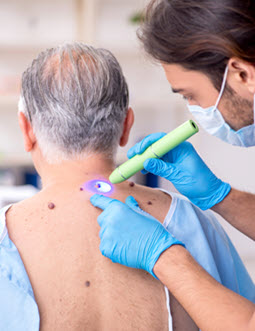Schedule a skin check skin cancer with routine screenings.
Schedule a skin check skin cancer with routine screenings.
Blog Article
Navigating Skin Cancer Treatment: The Vital Role of Mohs in Modern Dermatology Practices
Skin cancer, a complicated diagnosis, usually leaves patients grappling with numerous therapy choices. Among these, Mohs surgery stands as a sign in contemporary dermatology, renowned for its meticulous approach to cancer cells elimination and preservation of bordering healthy tissue. This cutting-edge method assures not just superior cosmetic results however likewise supplies instant outcomes, alleviating individual anxiousness. As we discover the details of this procedure, one will appreciate its critical duty in skin cancer treatment.
Comprehending Skin Cancer: Types and Threats
There are 3 primary kinds of skin cancer cells: Basal cell carcinoma, Squamous cell carcinoma, and Melanoma. It accounts for just concerning 1% of skin cancer cases but causes the vast bulk of skin cancer fatalities. Danger factors consist of reasonable skin, history of sunburn, excessive sunlight exposure, living at high elevations or close to the equator, having numerous moles, a household background of skin cancer, and deteriorated immune system.
What Is Mohs Surgical procedure and How It's Changing Skin Cancer Therapy
Regardless of the countless therapies presently readily available for skin cancer, Mohs surgery stands out as a groundbreaking and extremely effective solution. Named after Frederic E. Mohs, the medical professional who established the procedure, Mohs surgery is a specific medical technique used to deal with skin cancer cells. This level of precision, integrated with the ability to save as much healthy and balanced cells as possible, is changing skin cancer therapy.
The Benefits of Mohs Surgical Treatment Over Standard Skin Cancer Treatments
Building on the cutting-edge nature of Mohs surgery, it's essential to consider its many advantages over traditional skin cancer treatments. Unlike standard operating procedures, Mohs offers a greater treatment price, often getting to 99% for first-time treatments and 94% for recurring cancers. This accuracy is due to its one-of-a-kind approach of progressively removing and checking out tissue layers until just cancer-free cells continue to be (hair loss). Furthermore, it lessens damage to healthy and balanced skin, resulting in much less scarring and enhanced cosmetic results. Mohs additionally gives prompt outcomes, getting rid of the anxiety-ridden wait common with various other methods. Lastly, it's economical, as the surgical procedure and tiny examination take place simultaneously, eliminating the requirement for extra laboratory services. Hence, Mohs represents a substantial innovation in skin-related techniques.
The Procedure of Mohs Surgical Treatment: What to Anticipate Throughout the Process

Possible Side Impacts and Post-Operative Care of Mohs Surgical Procedure
Undergoing Mohs surgical treatment, like any other operation, involves possible side impacts that patients should know. Common adverse effects include pain, bruising, and swelling at the surgical procedure site. Nonetheless, these are normally temporary and convenient with non-prescription discomfort medication and ice packs. In rare cases, people may experience infection, blood loss, or an allergy to the anesthetic. Post-operative treatment is important to healing and lessening negative effects. This typically involves keeping the injury clean and completely dry, taking proposed medications, and preventing arduous activities. Clients must additionally attend all follow-up consultations for wound treatment and monitoring. In some instances, extra treatments might be necessary to make certain full elimination of the cancerous cells. Abiding by these post-operative care guidelines can substantially enhance recuperation view publisher site and results.
Conclusion

Report this page